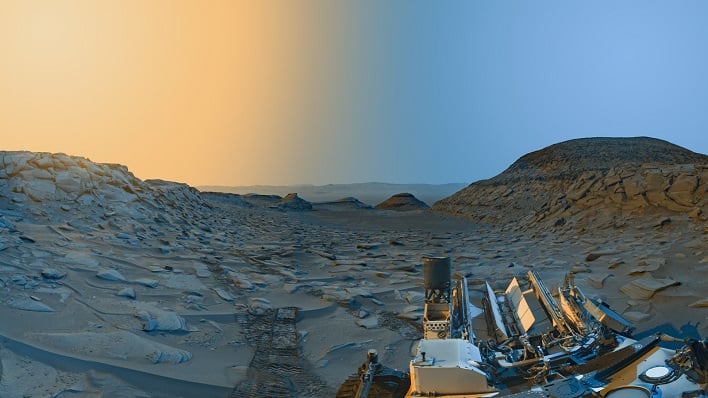NASA's Curiosity Rover Snaps A Breathtaking Panoramic Postcard Of Mars

NASA has shared some incredible images from Mars that its rovers have collected over recent years, from a dragon-like skeleton to shots of the Ingenuity helicopter flying above the Martian surface. The most recent image shared by the space agency gives a unique look at different times of day that the rovers are uniquely privy to.
As the Curiosity rover took in its last views from Marker Band Valley, it took two black and white panoramas with its navigation cameras. The first image was captured on April 8 at 9:20am, while the second was snapped at 3:40pm local Mars time. The two images provided a contrast of light, that when combined as an artistic interpretation of the landscape produced a cinematic view of the Red Planet.
Curiosity sent back similar images of Mars in 2021. Those images were taken high up on Mars' Mount Sharp and showcased the sweeping landscape of the Martian terrain.
Most of the images sent back from Curiosity are taken from its Mastcam instrument, which has a much higher resolution than the navigation cameras. Just as in the newest image, blue was added to parts of the scenery to represent morning time, and yellow to indicate parts taken in the afternoon.
The latest image is from the foothills of Mount Sharp, which stands 3 miles (5 kilometers) high within Gale Crater. Marker Band Valley, a winding area in the "sulfate-bearing region," can be seen in the distance. The valley is also where Curiosity unexpectedly discovered signs of an ancient lake. At the center-right of the image are two hills, "Bolivar" and "Deepdale."
"Anyone who's been to a national park knows the scene looks different in the morning than it does in the afternoon," remarked Doug Ellison, a Curiosity engineer. "Capturing two times of day provides dark shadows because the lighting is coming from the left and the right, like you might have on a stage, but instead of stage lights, we're relying on the Sun."
The postcard view is made even more dramatic due to it being winter on Mars, which has a period of lower airborne dust. This allows the rover to capture images that are much sharper and deeper than when there is a lot of dust blowing around, according to Ellison.



